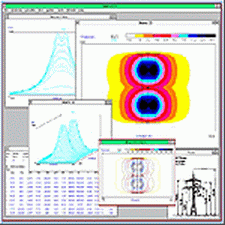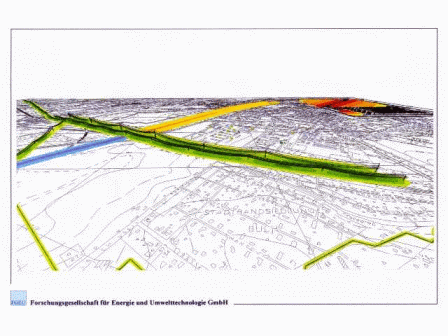Can electrosmog be measured, and who measures it?
| Various instruments are available for measuring exposure fluxes, and locally transferred and/or absorbed energies in different conditions. Programs and computation patterns, (fig. 1), have been studied for planning and predicting energy distribution around sources (fig. 2). In Italy, there are public surveillance services (see APAT and ARPA, waves in the field) and experts (professional freelance specialists) who carry out checks and make recommendations in this regard. |
|
|
|
Fig. 2:
Calculation pattern EFC-400. (Credit: Narda Safety Test Solutions) |
We have already said that the thermal effects![]() of radiation (whose threshold is
around
4mW
of radiation (whose threshold is
around
4mW![]() per square centimetre) are well known and are easily avoidable. But, nowadays,
effects difficult to recognise are feared also at lower
doses
per square centimetre) are well known and are easily avoidable. But, nowadays,
effects difficult to recognise are feared also at lower
doses![]() .
Even though little damage
.
Even though little damage![]() of this sort (non thermal
of this sort (non thermal![]() and
aspecific
and
aspecific![]() )
has been noted scientifically, it still receives wide coverage in the media.
They generally talk of a wide range of pathologies which are difficult to characterize (from the simple headache to leukemia
)
has been noted scientifically, it still receives wide coverage in the media.
They generally talk of a wide range of pathologies which are difficult to characterize (from the simple headache to leukemia![]() , from depression to
Alzheimer's disease
, from depression to
Alzheimer's disease![]() ,
from reduced libido to anorexia
,
from reduced libido to anorexia![]() ,
from a loss of balance to all forms of oncogenesis
,
from a loss of balance to all forms of oncogenesis![]() ).
The most feared
health problems are those which develop only later on, when a diagnosis is made only a long time (years, decades, even generations) after the event
that first induced the molecular modification. The problem is known as "long
term damage" which develops only when successive disturbances occur which spark off the atypical formation itself . It is evident that such behaviour complicates scientific studies and often weakens
epidemiological data
).
The most feared
health problems are those which develop only later on, when a diagnosis is made only a long time (years, decades, even generations) after the event
that first induced the molecular modification. The problem is known as "long
term damage" which develops only when successive disturbances occur which spark off the atypical formation itself . It is evident that such behaviour complicates scientific studies and often weakens
epidemiological data![]() . As a matter of fact, even the most serious epidemiological analysis cannot
give definite answers unless the observed effects abundantly exceed the
statistical error of the same pathologies present in the control groups.
Statistical fluctuations are usually very large because of the natural
heterogeneity of the human population and also because of the long observation
periods needed. Experimental studies "in vitro" and
"in vivo" exist, but there are many perplexities concerning the validity of transferring
the results directly to the human population. At the moment, it is
difficult both to state a correct "cause/effect" connection, and to indicate a
real pattern of the function that indicates the response according to the dose (linear
. As a matter of fact, even the most serious epidemiological analysis cannot
give definite answers unless the observed effects abundantly exceed the
statistical error of the same pathologies present in the control groups.
Statistical fluctuations are usually very large because of the natural
heterogeneity of the human population and also because of the long observation
periods needed. Experimental studies "in vitro" and
"in vivo" exist, but there are many perplexities concerning the validity of transferring
the results directly to the human population. At the moment, it is
difficult both to state a correct "cause/effect" connection, and to indicate a
real pattern of the function that indicates the response according to the dose (linear![]() /non-linear
response...?).
This makes it less meaningful to extrapolate patterns deriving from observed results for high doses.
/non-linear
response...?).
This makes it less meaningful to extrapolate patterns deriving from observed results for high doses.
We have briefly mentioned the difficulties regarding ELF![]() . As far as radiofrequencies
. As far as radiofrequencies![]() and
microwaves
and
microwaves![]() are
concerned we are better off, because the energy transferred to the crossed materials
can be
measured precisely
and the subsequent chemical and physical
modifications may be better understood. Exposure effects, then, may be referred
to the average absorbed energy, normally indicated as SAR
are
concerned we are better off, because the energy transferred to the crossed materials
can be
measured precisely
and the subsequent chemical and physical
modifications may be better understood. Exposure effects, then, may be referred
to the average absorbed energy, normally indicated as SAR![]() (specific absorbed rate). But at decreasing SAR and particularly for very low
doses
interpretation remains difficult.
(specific absorbed rate). But at decreasing SAR and particularly for very low
doses
interpretation remains difficult.
Living organisms manifest individual differences both in specific sensibility
and also in the reactions activated. Besides, even a minimal disturbance may
become the cause of serious damage if not recognized and repaired or eliminated
(think of carcinogenesis
on the one hand, and on the other consider
hormesis![]() ; i.e.
the possibility that a disturbance may become "beneficial" as it could
improve the system's ability to recognize anomalies and to defend itself and
return to normal). This possibility cannot be excluded a priori for the
electromagnetic
radiations
; i.e.
the possibility that a disturbance may become "beneficial" as it could
improve the system's ability to recognize anomalies and to defend itself and
return to normal). This possibility cannot be excluded a priori for the
electromagnetic
radiations![]() .
.
If we want to stick to the facts and answer people's worries about the damage caused by electrosmog![]() noxiousness, with more precise
answers also at low doses,
we have to wait until scientific observations are ready. For the moment, we can say that if a
real risk
noxiousness, with more precise
answers also at low doses,
we have to wait until scientific observations are ready. For the moment, we can say that if a
real risk![]() exists, it is so small that it gets confused in the normal
incidence intervals of the pathologies in question. At best, we should get
used to comparing this risk with the many others already known which we readily accept
without worrying. Such mental exercise is particularly useful for
our society,
which is not yet accustomed to perceiving and evaluating different risks. Too often the risks are not correctly described and often some of them are
blown up out of all proportion, while more serious ones are overlooked.
exists, it is so small that it gets confused in the normal
incidence intervals of the pathologies in question. At best, we should get
used to comparing this risk with the many others already known which we readily accept
without worrying. Such mental exercise is particularly useful for
our society,
which is not yet accustomed to perceiving and evaluating different risks. Too often the risks are not correctly described and often some of them are
blown up out of all proportion, while more serious ones are overlooked.
When we perceive a risk, we want to see it eliminated. This is clearly utopian, unless all the activities connected to the risk are also suppressed, thus also eliminating all the benefits that come with it.

